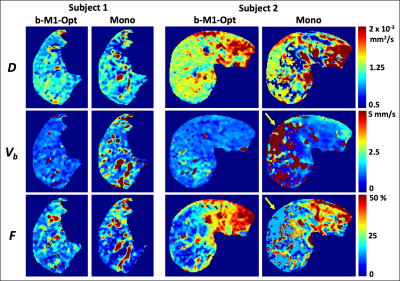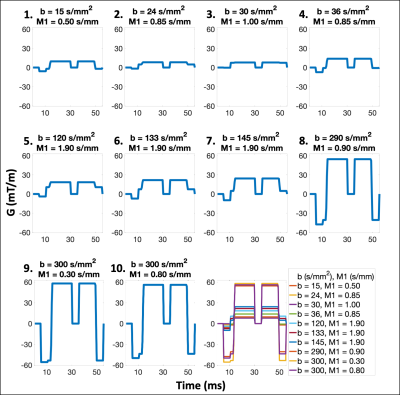Gregory Simchick1,2, Ruiqi Geng1,2, Yuxin Zhang1,2, and Diego Hernando1,2,3
1Radiology, University of Wisconsin-Madison, Madison, WI, United States, 2Medical Physics, University of Wisconsin-Madison, Madison, WI, United States, 3Biomedical Engineering, University of Wisconsin-Madison, Madison, WI, United States
1Radiology, University of Wisconsin-Madison, Madison, WI, United States, 2Medical Physics, University of Wisconsin-Madison, Madison, WI, United States, 3Biomedical Engineering, University of Wisconsin-Madison, Madison, WI, United States
b-M1-optimized waveforms were designed in order to obtain intravoxel incoherent motion (IVIM) mapping of the liver with improved stability in comparison to conventional monopolar waveforms.

Figure 5: Representative parametric maps of D (first row), Vb (second row), and F (third row) for the monopolar and ten-point b-M1-optimized data samplings for two subjects. Reduced variability in the estimates in the right lobe of the liver is observed for the estimates obtained using the b-M1-optimized sampling in comparison to the monopolar sampling. For the monopolar sampling, Subject 2 demonstrates areas of instability in the fitting (yellow arrows), whereas the b-M1-optimized sampling demonstrates stability.

Figure 2: b-M1-optimized waveforms associated with the Cramer-Rao lower bound (CRLB) b-M1-optimized data sampling (Figure 1b). Waveforms were designed by combining a monopolar gradient waveform with the M1-nulled gradient waveform, which allows for the simultaneous control of b and M1.9 Of these ten waveforms or data points in the b-M1-optimized sampling, numbers 1, 2, 5, 8, and 9 provide the optimal solution to Eq. (2) for a five-point b-M1-optimized sampling, and the addition of number 6 provides a six-point b-M1-optimized sampling.
